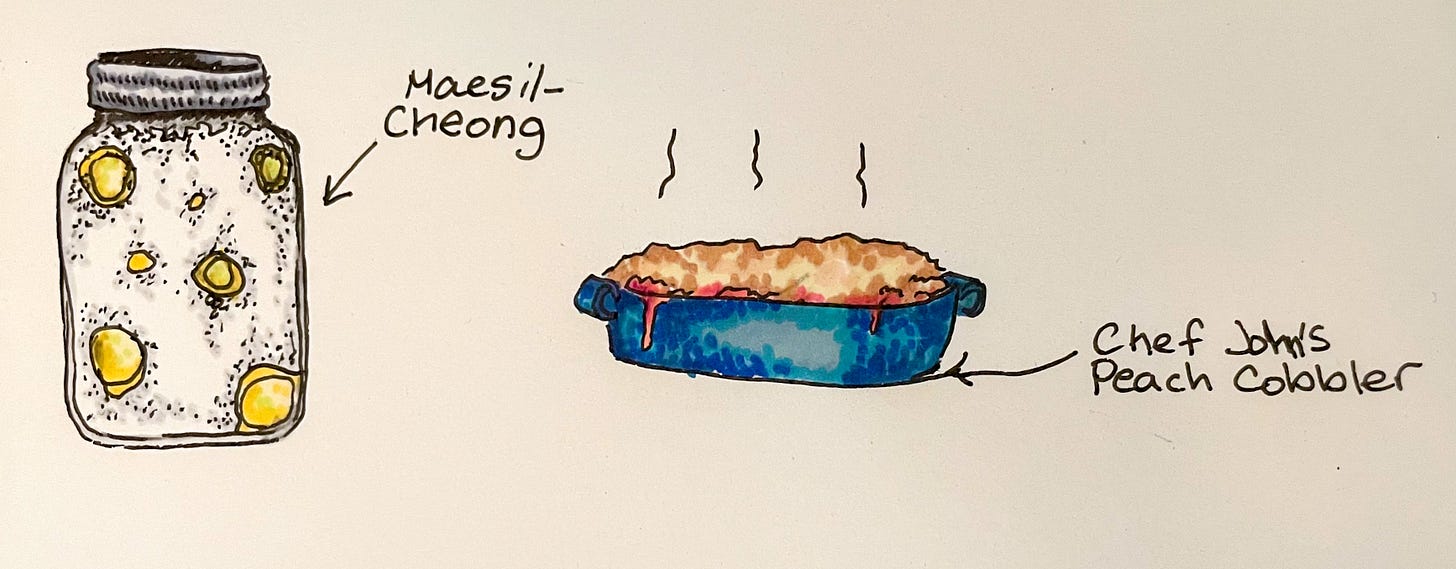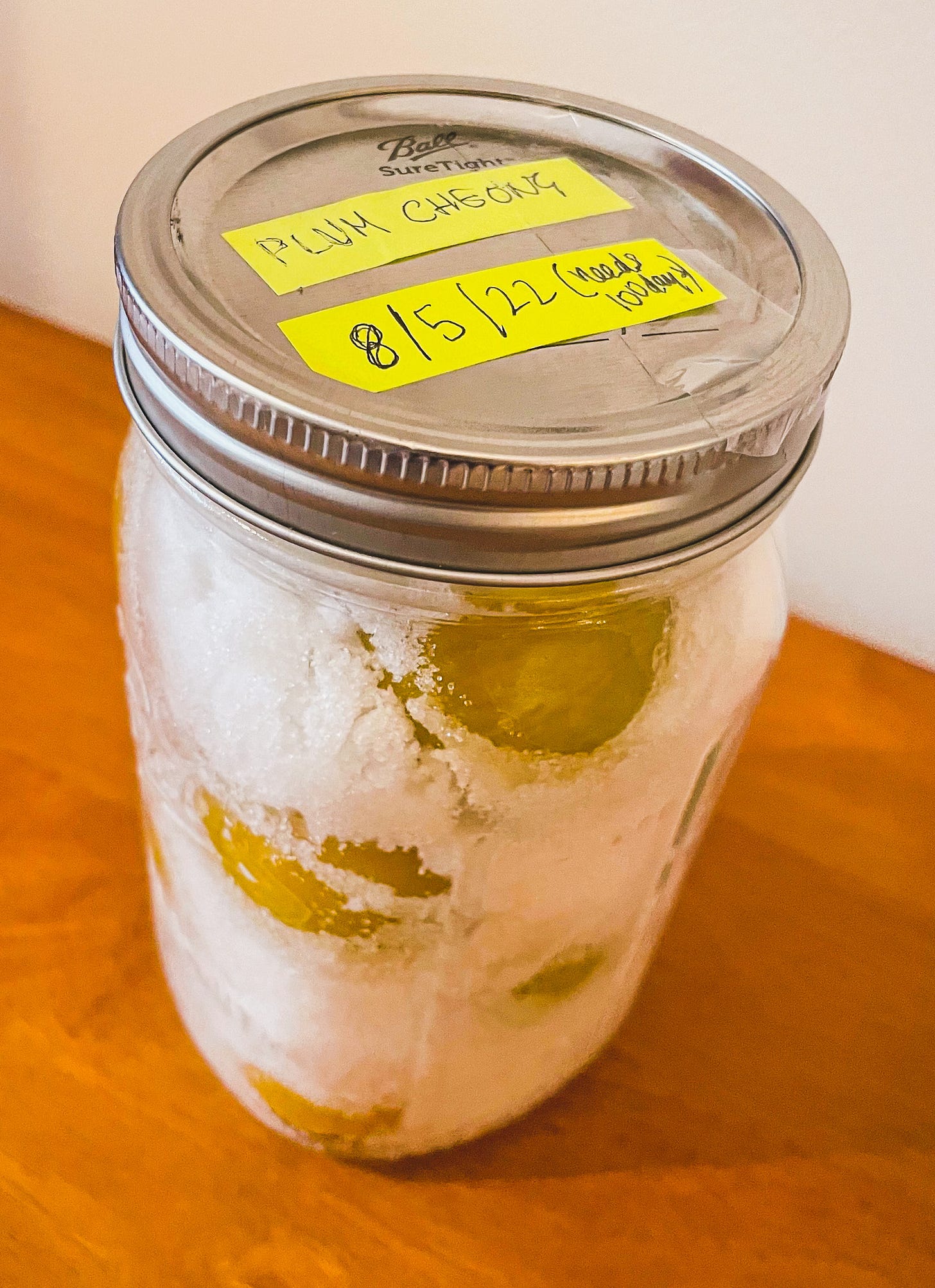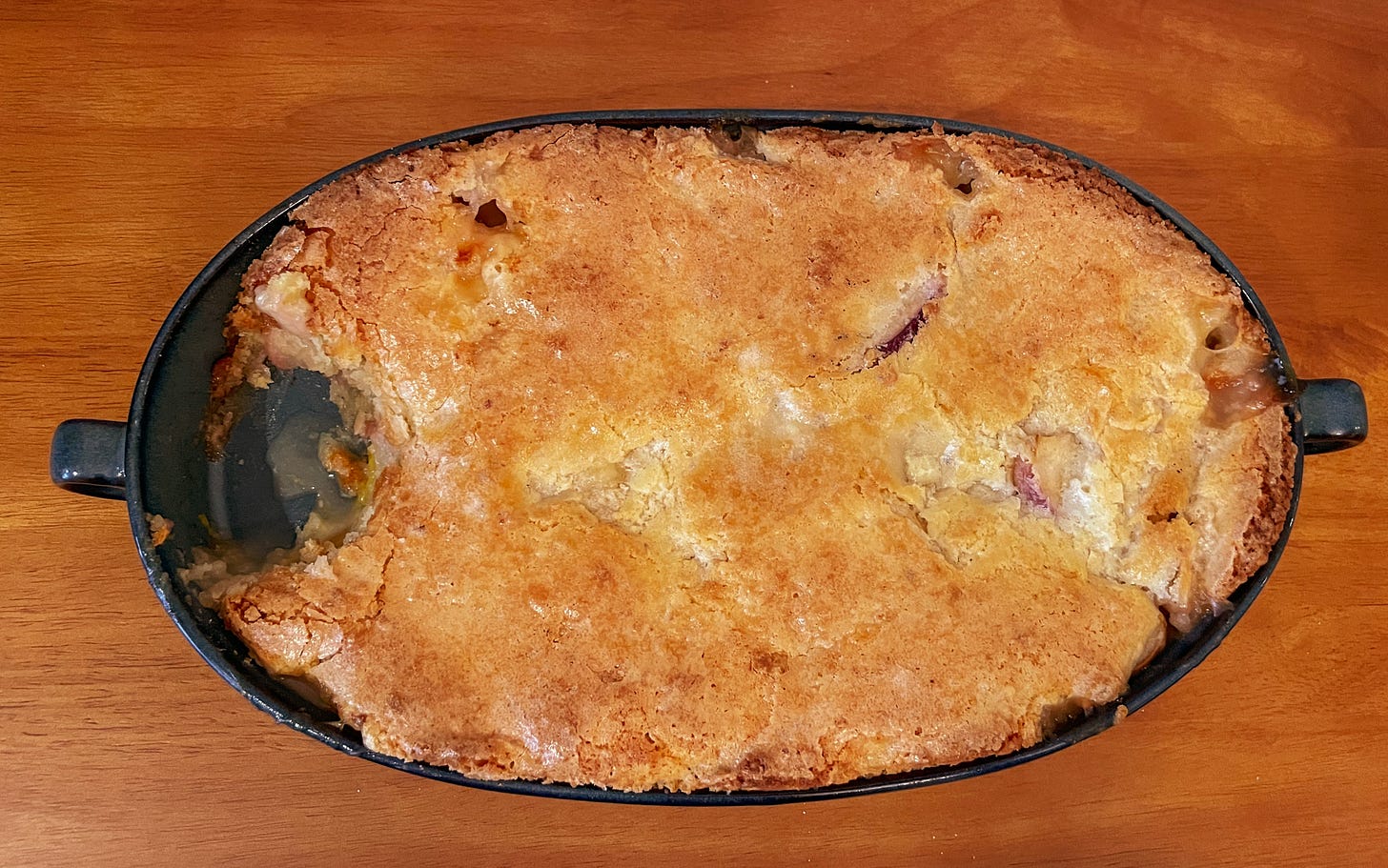Last Friday, I finally got wi-fi. The woman who came from Verizon, Cynthia, was terribly charming and disarmingly relaxed in the face of the 2005-era router that had been installed in my bedroom wall for god knows how long.
While she was in my apartment, I found myself floating up and down the length of it feeling a bit useless. I barely even hire cleaners without insisting that we split the work. I don’t know anything about Wi-Fi installation, so I was embarrassed to just sit there unable to help as she did her job.
I moved myself to the kitchen, where I made eyes at the hastily softening peaches and plums on my counter. I had ideas to make a fruit salad, but was too sleepy and busy during the week to ever get around to it. We were several days past salad suitability, and then I remembered a video I had seen from one Johnny Kyunghwo, in which he made plum Cheong. Cheong, broadly, refers to Korean syrups, preserves, and marmalades. Maesil-cheong is plum syrup, something I’ve seen used in teas and as a sweetener. I don’t have any particular need for plum syrup, but I supposed at the time that preserving them was better than letting them soften past the point of no return. My ratios weren’t perfect, but I wasn’t that concerned. You’re meant to have a 1:1 ratio of sugar to fruit, otherwise you risk it fermenting. If it does ferment, I don’t really mind, I’m just learned enough to make these kinds of mistakes safely. Cynthia was fascinated by the process, and she let me explain fermentation and pectins for about a half-hour as she wired everything. If she was bored, I couldn’t tell. On her way out, I gave her the instructions to make Cheong, because she refused beverages or snacks that I had offered previously. I had to give her something for her time. She seemed appreciative, though clearly bemused by the idea of leaving something to sit for 100 days.
As I followed her out to politely say good-bye, one of the automatically locking doors to my building closed behind me. Both mine and Cynthia’s eyes widened dramatically, and we both scrambled to ring every other doorbell in the building. The tiny old woman who lives upstairs poked her head out of the window, seeing Cynthia and not me.
Cynthia called up, “your neighbor accidentally locked herself out!”
The old woman yelped, “who?”
I craned my neck out to make eye contact with her, and said, “Hi, sorry! The door closed behind me!”
Wordlessly, she pitched a ziploc bag of keys out of the window.
I scrambled upstairs, my apartment door still wide open, to return the keys.
An hour later, I learned her name was Helen, she was home most days, the tenant before us was a bit of a sociopath with a penchant for psychologically torturing paranoid older women, her granddaughter was a dancer, and her whole family looks good in blue.
About the previous tenant: my guess is he was one of those types that likes to have people over all the time— nothing especially wrong with that, but one needs to consider the logistics of sustaining that lifestyle in a building like ours. Both front doors lock automatically, and there are signs all over the lobby begging us to keep them closed. There’s a little gate, too, which stays closed (there isn’t a latch, I think the landlord considers it more of a visual deterrent. Helen does, too, she seems to believe a closed gate is the only thing keeping “bums” from sitting on the stoop). Helen is particularly demanding about these things, which is fair enough: she’s usually alone and has the cable news on 24/7. Even the most rational, relaxed person will become a paranoid mess in days under similar circumstances. She told me the last tenant would leave the doors wide open all night, not just unlocked; he’d leave the gate open, too, and get rowdy in the yard. She’d complain, he’d get worse. When he finally moved, he didn’t move far. Helen told me he walks by fairly often and, presumably out of spite, swings open the gate as he passes. I briefly wondered if she was exaggerating, or had misinterpreted someone accidentally leaving the gate open once or twice, but that night as I lay in bed alone, I heard the unmistakable sound of the gate squeaking open. I waited, listening for the ca-thunk, clunk of the front door opening, but didn’t. I walked to the window and saw that the gate, which I know I had made a point to close barely an hour earlier, was wide open. Spooky.
On Sunday, Luke and I ran errands early, to avoid the impending heatwave both our phones had anxiously notified us about. I still needed something to do with the peaches and the three plums I couldn’t stuff into my Cheong jar. I had no idea.
While perusing the social media less traveled, coincidentally named Peach, I spotted a gorgeous cobbler my friend Megan made. She lives in Norway with her husband, so hers was made with rhubarb and red gooseberries. I knew immediately I, too, had to make a cobbler. I had done it before, but with canned biscuits— I wanted to do something a little more labor-intensive, a little more ‘from scratch’. When I’m wondering how to make something like this, there’s really only one person I go to. Chef John, from foooooodwishes. It’s not spelled like that, he just says it like that. It’s foodwishes.blogspot.com, he’s got a YouTube. If you’ve never heard of him, go look him up. He’s one of the best of the YouTube cooking teachers, focusing less on exacting step-by-step instructions and more on preparing you well enough to take control of cooking for yourself. More than anything he walks you through the basic idea of the dish. Food Wishes videos aren’t the kind that you have to look back on. Watch a video once and you essentially have the idea down.
One thing Chef John does well is introduce some interesting alterations to classic dishes. His cobbler technique includes a wet sugary glaze on the batter pre-bake, and I tell you it was stupendous. Crispy desserts are my favorite, but it can be difficult to toe the line between a pleasant crunch and palate-rending textures that more closely resemble glass. The glaze leaves the top few millimeters delicate and crispy, like fried lace, but the batter that touched fruit stayed moist and rich, taking on a pleasant pinkish color from the skins which I agree ought to be left on the fruit. The relative sweetness of the batter also infused nicely with the fruit, which were totally unsweetened (we even forgot the lemon zest and juice. Didn’t make much of a difference, the peaches were flavorful enough). Frankly, it was the most perfect fruit dessert I’d made in a long time.
If you’re looking for something to do with some soft fruit, you have two potential options: a batch of Cheong, or a cobbler. They’re both pretty easy, straightforward, low-effort and low-mess things to do. One won’t be enjoyed until the colder months, and the other is one of the summeriest desserts I can think of, and wants desperately to be consumed before August is out. Living in the present as well as in the future is IN!







